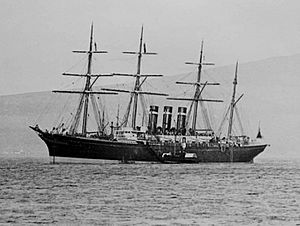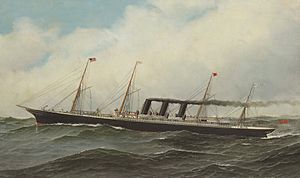SS City of Rome facts for kids

City of Rome
|
|
Quick facts for kids History |
|
|---|---|
| Name | City of Rome |
| Owner | |
| Operator | Anchor Line (1881–1900) |
| Port of registry | |
| Route | trans-Atlantic (1881) |
| Builder | Barrow Ship Building Co |
| Launched | 14 June 1881 |
| Commissioned | 1881 |
| Maiden voyage | 13 October 1881 |
| Fate | Scrapped 1902 |
| General characteristics | |
| Type | Ocean liner |
| Tonnage |
|
| Length | 560.2 ft (170.7 m) |
| Beam | 52.3 ft (15.9 m) |
| Depth | 37.0 ft (11.3 m) |
| Installed power | 1,500 NHP |
| Propulsion | 3 × 2-cylinder compound inverted steam engines |
| Sail plan | 4-masted; barque, then schooner |
| Speed |
|
| Capacity |
|
The City of Rome was a large British ocean liner, a type of ship that carries passengers across oceans. It was built by the Barrow Ship Building Company for the Inman Line. This company wanted it to be the biggest and fastest ship crossing the North Atlantic Ocean.
However, the ship did not perform as well as expected. After only six trips, it was sent back to Barrow-in-Furness, where it was built. The Anchor Line then took over managing the ship. It sailed on different routes until the year 1900. The City of Rome was taken apart for scrap metal in 1902.
Contents
Building the City of Rome
In 1879, another ship called the Arizona was finished. This made all big companies that sailed across the Atlantic Ocean think about building new, fast passenger ships. The City of Rome was the Inman Line's answer to this challenge.
Ship Design and Features
William John designed the City of Rome. He later designed the first battleship for the United States Navy, the USS Texas. The City of Rome was much larger than other ships. It was meant to cross the Atlantic at about 18 knots (33 km/h).
The ship could carry 520 first-class passengers. Their rooms were very fancy and comfortable. It also had space for 810 passengers in the cheaper steerage class. The City of Rome was one of the first ships to have all its lights powered by electricity.
Building Challenges
The original plan for the ship was to use a steel hull. However, the builders, Barrows, convinced Inman to use iron instead. At that time, it was hard to get enough steel, which was a newer metal.
Because of this change to iron, and some mistakes in calculations, the City of Rome's draught was too deep. This means it sat too low in the water.
Engines and Power
At first, the builders thought about using two screws to move the ship. But they decided against it. The ship had boilers that made steam at 90 pounds per square inch. This steam powered three engines that drove a single screw.
These engines produced 1,500 Nominal Horsepower. This was only 75% of the power the ship was supposed to have. The City of Rome was finished in June 1881.
Performance Issues
Because the ship was not powerful enough, too heavy, and sat too low in the water, it only reached 15.75 knots (29.17 km/h) during its sea trial. Also, it could only carry 2,200 tons of cargo. This was much less than the 3,800 tons that were planned.
City of Rome at Sea
In August 1882, the Inman Line decided they didn't want the City of Rome anymore. This was after only six trips across the Atlantic. The ship was not performing as well as they had hoped. A long court case followed, and Barrows, the builders, lost.
Managed by Anchor Line
The Anchor Line was connected to Barrows. They were given the job of managing this difficult ship. Barrows changed the ship's engines and made it lighter. After these changes, the City of Rome could reach an impressive 18.25 knots (33.80 km/h) in new tests.
Starting in May 1883, Anchor Line used the ship on the route from Liverpool to New York. Passengers found it comfortable and popular. However, the ship still didn't make enough money. This was because it didn't have another ship of similar size to sail with. Anchor Line tried to fix this, even pairing it with another ship called America in 1886. But none of these plans worked well.
Later Years and End of Service
In 1891, the City of Rome stopped sailing from Liverpool. It was moved to the Glasgow – New York route. Here, it sailed with ships that were only half its size. The way passengers were arranged on the ship also changed. It now had 75 first-class passengers, 250 second-class, and 1,000 steerage passengers.
In September 1898, after the Spanish–American War ended, the United States government hired the City of Rome. It was used to take Spanish Navy prisoners of war back home. The next year, the ship was damaged when it hit an iceberg.
In 1900, the City of Rome served Britain as a troopship during the Second Boer War. Later that year, it was sold to a German company that breaks up old ships. But instead, it sailed for a short time on the Glasgow – Moville – New York route.
By this time, the ship was clearly old and nearing the end of its life. One trip took eleven days. It left Glasgow on September 27, 1900, and didn't reach New York until October 8, 1900. During this trip, it had two engine breakdowns. The first one took 14 hours to fix. The second happened three days later, and the ship was tossed around in rough seas for four hours.
By 1902, the decision was made to take the ship apart for scrap metal. It arrived in Lemwerder, Germany, in January 1903 to be broken up.
The Ship's Automaton
In March 2010, a special moving toy, called an automaton, from the City of Rome was in the news. It was sold at an auction in New Zealand. It had been part of a private collection of automatons there.
In the 1920s, this automaton was shown at the London Mechanical and Electrical Exhibition. This exhibition traveled across England, Europe, Australia, and New Zealand. People think the automaton was made in the 1880s. It was likely used as an advertisement to get people to want to travel on the ship.
The automaton shows a ship sailing in front of a moving background. You can see waves below the ship and a hot air balloon floating above it. The automaton needed some repairs to its masts and rigging. It was sold for NZ$7,000.


